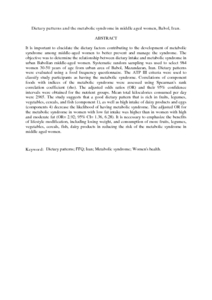Citation
Delavar, Mouloud Agajani and Lye, Munn Sann and Khor, Geok Lin and Syed Hassan, Syed Tajuddin and Hanachi, Parichehr
(2009)
Dietary patterns and the metabolic syndrome in middle aged women, Babol, Iran.
Asia Pacific Journal of Clinical Nutrition, 18 (2).
pp. 285-292.
ISSN 0964-7058; ESSN: 1440-6047
Abstract
It is important to elucidate the dietary factors contributing to the development of metabolic syndrome among middle-aged women to better prevent and manage the syndrome. The objective was to determine the relationship between dietary intake and metabolic syndrome in urban Babolian middle-aged women. Systematic random sampling was used to select 984 women 30-50 years of age from urban area of Babol, Mazandaran, Iran. Dietary patterns were evaluated using a food frequency questionnaire. The ATP III criteria were used to classify study participants as having the metabolic syndrome. Correlations of component foods with indices of the metabolic syndrome were assessed using Spearman's rank correlation coefficient (rho). The adjusted odds ratios (OR) and their 95% confidence intervals were obtained for the nutrient groups. Mean total kilocalories consumed per day were 2965. The study suggests that a good dietary pattern that is rich in fruits, legumes, vegetables, cereals, and fish (component 1), as well as high intake of dairy products and eggs (components 4) decrease the likelihood of having metabolic syndrome. The adjusted OR for the metabolic syndrome in women with low fat intake was higher than in women with high and moderate fat (OR= 2.92; 95% CI= 1.36, 6.28). It is necessary to emphasize the benefits of lifestyle modification, including losing weight, and consumption of more fruits, legumes, vegetables, cereals, fish, dairy products in reducing the risk of the metabolic syndrome in middle aged women.
Download File
![[img]](http://psasir.upm.edu.my/14060/1.hassmallThumbnailVersion/Dietary%20patterns%20and%20the%20metabolic%20syndrome%20in%20middle%20aged%20women.pdf)  Preview |
|
PDF (Abstract)
Dietary patterns and the metabolic syndrome in middle aged women.pdf
Download (85kB)
| Preview
|
|
Additional Metadata
Actions (login required)
 |
View Item |

